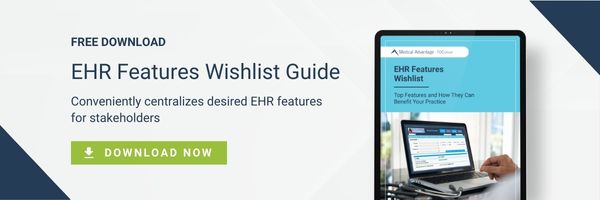The quest for better outcomes in patient care may stem from multiple motivations, but as healthcare continues to shift toward value-based care, this is becoming a common pursuit. Missing the mark for such outcomes can be traced back to gaps in care. However, the electronic health record (EHR) system can help medical practices resolve clinical gaps in care.
What are Gaps in Care?
A term like gaps in care could be associated with various aspects of healthcare, but it refers to one specific phenomenon – the disparity that exists between what is recommended for quality care versus what care is currently carried out. Gaps in care examples include:
- Patient groups not informed of preventative care they need according to risk, such as mammograms and vaccines
- Lack of patient adherence to care plans
- Patients not having access to the care they need
Gaps in care can not only prevent patients from achieving a higher level of wellness, they also can lead to increased healthcare costs. To better manage costs, private payers and government programs like Medicare want to prevent costly outcomes such as chronic conditions that lead to hospital readmissions.
To ensure that providers address gaps in healthcare, health plans like the Centers for Medicare and Medicaid Services (CMS) routinely monitor quality measures through Star Ratings and the Healthcare Effectiveness Data and Information Set (HEDIS) measures.
How EHR Optimization Confronts Gaps in Healthcare
EHRs can address gaps in care in a variety of ways, but the solutions at the forefront include enhanced reporting, patient engagement tools, interoperability, and better training.
1.) Optimize the EHR for Targeted Patient Population Management Reporting
Confronting gaps in care with the help of your EHR begins with getting the right data insights. EHRs supply patient population health data such as patient demographics, diagnosis, treatment, and outcomes, which can be used to inform quality improvement initiatives. When aggregating key data into reports, those tasked with patient population management can find trends that reveal where gaps exist, both moderate and severe.
For example, a report may uncover that several patients were never contacted by their primary care provider (PCP) for a follow-up visit following a release from the hospital. Another example – a Federally Qualified Health Center (FQHC) for women may discover that patients over 50 are not getting mammogram screenings.
2.) Optimize the EHR to Support Patient Engagement
The level of patient engagement needed to affect change cannot be reached when patients are not given the means. EHRs were invented to leverage technology for the improvement of access to patient information, and this same objective applies to patient involvement.
EHRs dispense information to patients through the portal, so the flow of information between the systems must be geared toward engagement. To ensure that the patient portal empowers patients to track their health progress, it must provide all the information they need to follow their care plan through convenient portal access.
EHRs also can support the portal in patient engagement by:
- Sending reminders for scheduled appointments and appointments that need to be scheduled
- Sending reminders to return for routine care such as vaccine boosters
- Automatically scheduling rides for patients who require accommodation for transportation
- Allowing patients to send messages to physicians directly and having these communications tracked
- Allowing patients to review reports such as lab work results
- Generating patient education materials associated with diagnoses
Engagement garnered through the patient portal is surely a bridge that can close gaps in care. Providers can help increase utilization of the patient portal by directly encouraging patients to try it and use it often. For example, if a patient calls the office about their lab results, staff can remind them that the reports can be found in the portal.
3.) Optimize the EHR to Reach Interoperability Goals
What if the reports you use to find gaps in care are not accurate because they do not have complete data? This can happen when the EHR is not functionally interoperable. To eliminate the inefficiencies associated with gaps in care, gaps in interoperability must be addressed as well.
Incomplete patient data factors into gaps in care and can lead to an overcorrection when redundancies occur in patient care. For example, a new provider orders a test already given within the last six months or prescribes medication for a condition already being treated by another prescribed medication.
Interoperability maintains that electronic health information should be exchanged securely, in the most accessible way, without special effort, and to mitigate information blocking. Not only is this a best practice for EHRs, but it also is a government mandate set in place with legislation such as HITECH and the 21st Century Cures Acts. To ensure that gaps in care are neither false nor underreported, the EHR must be conducive to interoperability to an extent that makes patient information complete and accurate.
4) Get the Most from EHR Optimization Through Effective Training
When it comes to having an EHR that works to close gaps in care, optimization is only part of the equation. Once an EHR is set up for efficiency that improves quality, sufficient training must be provided for users to properly utilize the EHR.
Clinicians and staff must know what EHR alerts mean and how to correctly respond to the alerts, especially ones that are set up to bring up patient care action items that are overdue. To dismiss important alerts while rushing through the steps will easily perpetuate gaps in care.
Explaining why the EHR is set up for a new workflow is just as important – if not more important – than learning the functions of the interface. When users understand the reason for the processes and alerts, and how they are set up to follow recommendations for patient care standards, they are empowered to do their part to close and prevent gaps in care.
Summary: Closing Gaps in Care Through EHR Optimization
When optimized, EHRs are a powerful ally in preventing and resolving gaps in care. When recommended treatment plans are followed, providers can catch conditions sooner and intervene, or prevent conditions from happening.
Gaps in care are not only detrimental to patients, but also costly for payers when more expensive care is needed to make up for a substantial lack of preventative care. Closing these gaps in care requires the consistent dedication of healthcare organizations, and EHR systems are instrumental for the success of this mission. To address gaps in care, EHR systems can:
- Capture critical data needed to track patient adherence to care plans
- Provide the aggregate patient data needed to assess gaps in care within a patient population
- Support a patient portal that facilitates patient engagement
- Encourage buy-in from physicians and staff through EHR training
To affect change for better patient care outcomes, medical practices must insist upon reliable data management, properly integrating EHRs with other systems, sufficient training, satisfactory user experience, and promoting patient engagement.
Eliminate Gaps in Care with a Full Practice Assessment and EHR Optimization Plan
To control healthcare costs, and for quality care that improves care outcomes, system optimization must occur so that key data can be utilized effectively. More often than not, out-of-the-box base versions of EHR systems are not equipped with the interoperability and patient portal integration needed to improve your operations.
Seasoned healthcare consultants at Medical Advantage understand the importance of keeping patients on track toward the best care outcomes. This begins with an assessment of both the medical practice and the EHR. We also offer ongoing support for training and helpdesk services. If you have any questions about how EHR optimization can keep cost control on track, reach out today!






